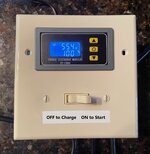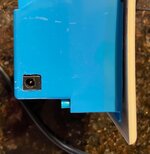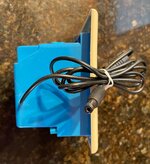rounds
Member
- Region
- USA
- City
- Chicago
Do you simply mean to run a wire from the battery controller terminalTry the momentary contact switch (or even just any switch operated manually) with the battery as the CD60 Input.
Funny... I thought of the same auxiliary power supply solution but kept scratching trying to think of something simpler and safer.
Thanks, but now I see why I wasn't getting it... This won't work any differently than what I already posted and isn't applicable; I'll explainThis is what I am thinking.
excuse the crude drawing as well
View attachment 115301
When you push the button you will in essence connect the charger directly to the battery. Once charging starts, release the button. It should only take a second or two.
You can test this with a regular throw switch before going through the trouble but I highly recommend using a momentary contact switch so that you don't accidently leave the switch in the wrong position on a final build. I can't guarantee that this will work, but if the battery charge port goes dead after charging stops, I don't see why not. Timing of this in the battery is the unknown...but the dOP can help here as well with any delay

Push Button Switch Panel Mount with 5 Feet wire SPST Momentary OFF/ON RED | eBay
Red Push Button Switch. Panel Mount Design.www.ebay.com

Momentary Green Pushbutton Switch - Panel Mount - SPST N.O. - 1/4" Mounting Hole | eBay
Panel mount design.www.ebay.com
What ever style it should be a Momentary Pushbutton Switch - SPST N.O. in function
let me know what you think or if something needs clarification
Upon first power up, the charger does provide power to the CD60 right from the start and the CD60 turns on. If I plug the charger/CD60 into the battery, the CD60 will function properly and charge the battery until the programmed voltage is reached.
The problem begins once the battery reaches the programmed voltage. The CD60 then shuts off power to the battery. For whatever reason (smart charger), this then causes the charger to momentarily power down for about 2-3 seconds. This charger power down occurs immediately after the CD60 has cuts power to the battery. So for 2-3 seconds the CD60 has no power and goes black.
Then after 2-3 seconds, the charger relay clicks and applies power again, the CD60 powers up and it's relay clicks to send power to the battery, the battery charge port then comes online, then the CD60 reads the battery voltage as sufficient, and the CD60 cuts the power to the battery which makes the charger cut power to the CD60... so the cycle of charger on/off/on/off, CD60 on/off/on/off, and battery voltage coming online offline on/off/on/off. This happens indefinitely because each time the CD60 gets fresh power it reboots and dOP resets from its programmed countdown from scratch (always will start over at 900 seconds or whatever it's programmed to).
If you haven't watched the video check it:
The video shows what happens when a full charge is reached without a secondary power supply for the CD60.
I will probably try and hack the CD60 so that the battery charger doesn't supply the power for the CD60 assuming I can figure out the traces on the CD60 PCB.
craigr



